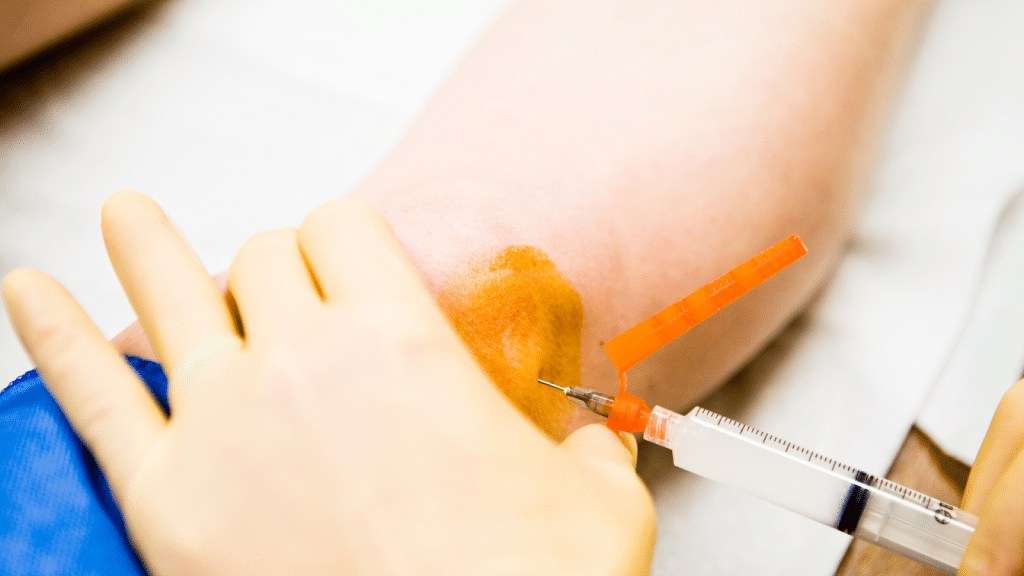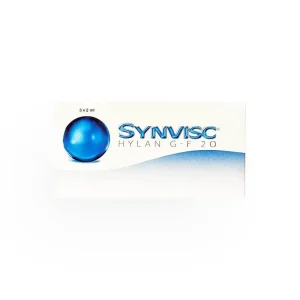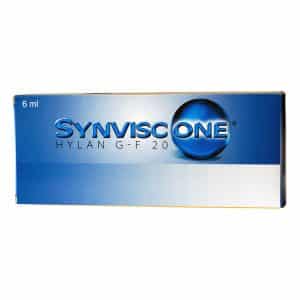Affecting approximately 528 million people worldwide, osteoarthritis has become a significant global health concern. This degenerative joint disease often results in pain, stiffness, and reduced mobility, severely impacting the quality of life for millions.
Synvisc is a widely-used viscosupplement injection designed to relieve knee pain caused by osteoarthritis. It mimics the natural synovial fluid in the knee joint, providing lubrication and cushioning to reduce discomfort and improve mobility. Synvisc is a popular choice for patients seeking non-surgical solutions for joint pain.
In this article, we will explore the recommended Synvisc dosage, prescribing information, and key guidelines for ensuring safe and effective treatment.
Key Takeaways
- Synvisc is a viscosupplement designed to relieve knee pain caused by osteoarthritis by mimicking the natural synovial fluid in the joints.
- It is commonly prescribed for patients who have not found relief through other treatments such as oral medications or physical therapy.
- Synvisc offers two dosing schedules: the standard three injections over three weeks or a single injection with Synvisc-One.
- This treatment can provide up to six months of relief and is generally well-tolerated, though some patients may experience mild side effects such as swelling or discomfort at the injection site.
- Synvisc is also explored off-label for other joints, including the hips and shoulders.
About: Medical Spa RX provides medical practices with premium products at the best prices. If you’re looking to buy Synvisc for your practice, the sales representatives at Medical Spa RX can give you guidance.
What is Synvisc?
Synvisc is a viscosupplement used to treat osteoarthritis (OA) by mimicking the natural synovial fluid found in the joints. This injectable treatment contains hylan G-F 20, a derivative of hyaluronan, which works as a lubricant and shock absorber for the affected joints.
Purpose of Synvisc in Medical Practice
Synvisc injections are primarily prescribed to reduce pain and improve joint function in patients with osteoarthritis. By replenishing the synovial fluid in the joints, they enhance lubrication and reduce friction between bones, helping patients manage OA symptoms more effectively. Medical professionals often recommend Synvisc knee injections for individuals who have not found relief through traditional methods like oral medications or physical therapy.
In the ongoing comparison of Synvisc vs Euflexxa, both products serve similar purposes in treating knee OA, but Synvisc offers a unique formulation with hylan G-F 20, whereas Euflexxa uses sodium hyaluronate.
Synvisc is versatile, as it’s not just limited to the knee—Synvisc injections for hips and Synvisc for shoulder have also been explored, though the treatment remains off-label for these joints.
Dosage Recommendations for Synvisc
The Synvisc dosage typically involves a series of three injections administered directly into the affected joint, such as the knee, at one-week intervals. Each injection contains 2 mL of Synvisc, which helps restore the synovial fluid’s cushioning and lubricating properties.
Dosage adjustments may be necessary for specific patient populations. For instance, patients with severe osteoarthritis or those who have not responded to other treatments might require a tailored approach.
Healthcare providers may take extra precautions when treating elderly patients or those with other health conditions to monitor the patient’s response and ensure that they tolerate the treatment well.
Frequency of Administration
For the original Synvisc treatment, patients receive one injection per week for three consecutive weeks. Synvisc-One, however, is a single 6 mL injection that can provide up to six months of relief with just one visit.
The frequency of administration can vary depending on the patient’s response to the initial treatment, and additional injections may be administered after a six-month period if symptoms return.
Administration Techniques for Synvisc
When administering Synvisc, the injection site is crucial for ensuring optimal results. For knee injections, the preferred site is the space between the patella (kneecap) and the femur.
This location allows the Synvisc to be delivered directly into the synovial cavity, where it can provide the most benefit. For other joints, such as the hip or shoulder, the injection site will vary based on the joint’s anatomy and the physician’s expertise.
Proper Injection Technique
The Synvisc injection must be administered by a trained healthcare professional, typically an orthopedic specialist or rheumatologist. The injection process involves the following steps:
- Preparation: The patient is positioned to allow full access to the treated joint. The injection site is sterilized with an antiseptic to prevent infection.
- Aspiration (if necessary): Before administering the injection, the healthcare provider may remove any excess fluid from the joint to enhance the effect of Synvisc.
- Injection: The doctor injects the Synvisc solution directly into the joint space using a sterile syringe and needle. For knees, the injection is typically administered through the side of the kneecap.
- Post-Injection Care: Patients are advised to limit strenuous activity for 48 hours to allow the solution to distribute evenly in the joint after the injection.
Handling and Storage of Synvisc
To maintain its integrity, Synvisc should be handled and stored according to the manufacturer’s guidelines. It should be kept at a temperature between 2°C and 30°C (36°F and 86°F) and should not be frozen.
Synvisc should be inspected before administration for particulate matter or discoloration. Proper handling and storage are vital to ensure the product’s effectiveness and patient safety.
Contraindications and Considerations
Certain patient populations should avoid using Synvisc. These include the following:
- Patients with known allergies to hyaluronan or avian (bird) proteins, as Synvisc contains components derived from rooster combs. Those with a history of allergic reactions to hyaluronic acid products may also be at risk.
- Patients with joint infections or skin infections at the injection site should not receive Synvisc until the infection has been resolved. Injecting Synvisc into an infected joint can worsen the condition and cause severe complications.
- Patients with severe inflammatory joint diseases, such as rheumatoid arthritis or gout, should consult their healthcare provider before receiving Synvisc, as the injection may not provide effective relief for non-osteoarthritis joint conditions.
Potential Drug Interactions
While Synvisc is generally safe, it’s important to consider potential drug interactions. Patients should inform their healthcare provider about all medications they are currently taking, including over-the-counter drugs and supplements.
Although there are no well-documented interactions with Synvisc, caution is advised when combining it with other intra-articular treatments to avoid adverse effects.
Adverse Reactions and Precautions to Consider
Adverse reactions to Synvisc are typically mild and may include localized pain, swelling, or redness at the injection site. In rare cases, patients may experience more severe reactions, such as joint infection or allergic responses. It’s crucial to monitor patients for any signs of adverse reactions following the injection and to provide appropriate care if needed.
Conclusion
Synvisc is a popular and trusted treatment for managing knee pain caused by osteoarthritis. It offers relief for up to six months. Administered through knee injections, it helps improve joint mobility and reduce discomfort.
The dosing schedule varies, with patients receiving either one large injection or a series of three smaller doses. Consulting with a healthcare professional is essential to determine the best treatment plan based on your health history and individual needs.
By working closely with your doctor, you can maximize Synvisc’s benefits and achieve long-lasting relief from osteoarthritis symptoms.
FAQs
1. What is Synvisc, and how does it work?
Synvisc is an injectable treatment for knee osteoarthritis that mimics the natural synovial fluid in the joint. It provides lubrication and cushioning, helping to reduce pain and improve mobility in patients with osteoarthritis.
2. How long does Synvisc last?
The effects of Synvisc can last up to six months, though some patients may require additional injections after this period, depending on their symptoms and individual response to treatment.
3. What is the difference between Synvisc and Synvisc-One?
Synvisc is typically administered in a series of three weekly injections, whereas Synvisc-One is a single larger dose designed to provide the same relief in just one visit.
4. Can Synvisc be used for joints other than the knee?
While Synvisc is FDA-approved for knee osteoarthritis, it has been explored off-label for other joints, including the hips and shoulders, though its safety and effectiveness for these areas are less well-established.
References
World Health Organization. Osteoarthritis. Published July 14, 2023. https://www.who.int/news-room/fact-sheets/detail/osteoarthritis
Buelt A, Narducci DM. Osteoarthritis Management: Updated Guidelines from the American College of Rheumatology and Arthritis Foundation. AAFP. Published January 15, 2021. https://www.aafp.org/pubs/afp/issues/2021/0115/p120.html
Drugs.com. (n.d.). Synvisc-One side effects. Drugs.com. Retrieved from https://www.drugs.com/sfx/synvisc-one-side-effects.html





















